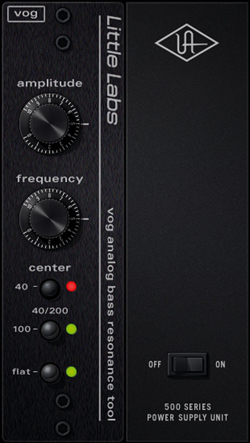Little Labs: Voice Of God Review
Does Universal Audio’s new Voice of God deliver the ultimate low-end lift? Mark Cousins moves some air…


Originally built for API’s 500-Series format, Little Labs’ aptly named Voice of God (VOG, for short) has gained a lot of respect for the extra definition and weight it delivers to the low end. Following on from modelling Little Labs’ functional IBP Phase Alignment Tool, therefore, Universal Audio has now turned its attention to the VOG. But what makes the VOG so special, and can it really produce that elusive ‘big bottom’ so many engineers desire?
Word From Above
Although the precise nature of what’s happening inside the VOG is hard to pin down, it is apparent that both the hardware and software versions of the unit work as a form of filter-based equalizer. In short, the VOG doesn’t create additional harmonics (like some other bass-enhancement tools on the market) but instead uses a cleverly positioned resonant high-pass filter to achieve a distinctive ‘bass-lift’ effect. By providing both a lift and a cut to the input, the VOG appears to achieve that elusive quality of low-end enhancement – namely, a bigger bass without all the associated mud.
In use, the VOG takes a little adjusting to, especially in relation to its set of controls, which Universal Audio has so faithfully modelled. The difficulty relates to the two centre-frequency selectors, which enable you to switch the VOG plug-in between four different frequency-based starting points. At first it isn’t apparent what the VOG is tuned to (the tip here is to remember that the red LED effectively means that the control is selected, green is unselected), but with practice and by using your ears, the current selection soon becomes apparent.
Big Bottom
Once you’ve set the centre frequency you have two principal controls to play with: another Frequency control (this time to fine-tune the starting frequency), and an Amplitude control (to set the amount of boost applied). We fed the VOG a drum track and were immediately impressed by its performance. Assuming that you’ve got some bass to play with initially, the VOG really makes the low end ‘sing’, particularly kick drums, which gain extra weight that’s often difficult to achieve with EQ. The range of the VOG plug-in also makes it a great choice for male vocals, adding a degree of proximity effect and power to an otherwise weak vocal line.
If you’ve got time, patience and experience on your side, the results the VOG can achieve could conceivably be re-created using a suitably powerful parametric equalizer. However, because it’s exclusively deigned for one task, the VOG can really shine in its application, providing a degree of flexibility and interaction (for example, the amount of cut increases as you push the VOG harder) that’s hard to achieve using EQ alone. Interestingly, it’s also pertinent to note how little the VOG changes the overall output levels in respect to increasing the amplitude of the effect. In short, you can add plenty more bass without eating up another 6dB of headroom across your stereo buss.
Ace Bass
By cherry-picking the best studio hardware, Universal Audio continues to deliver some of the most usable and sonically effective audio-processing tools in the software world. The VOG might be a bit specialist, but the immediacy and ease with which it delivers results will please many engineers who are new to its sound. Ultimately, the VOG solves a bass problem that most of us have encountered at some point, and for that reason is well worth having to hand.
WHY BUY
Instant big bass
Avoids muddying the sound
Immediate and effective results
Works on a range of sources
WALK ON BY
Frequency switches difficult to understand
Could be replicated with EQ
Verdict
A quick and effective solution for low-end enhancement – the VOG plug-in delivers surprisingly controlled bass without any of the muddiness of traditional EQ.
9/10


